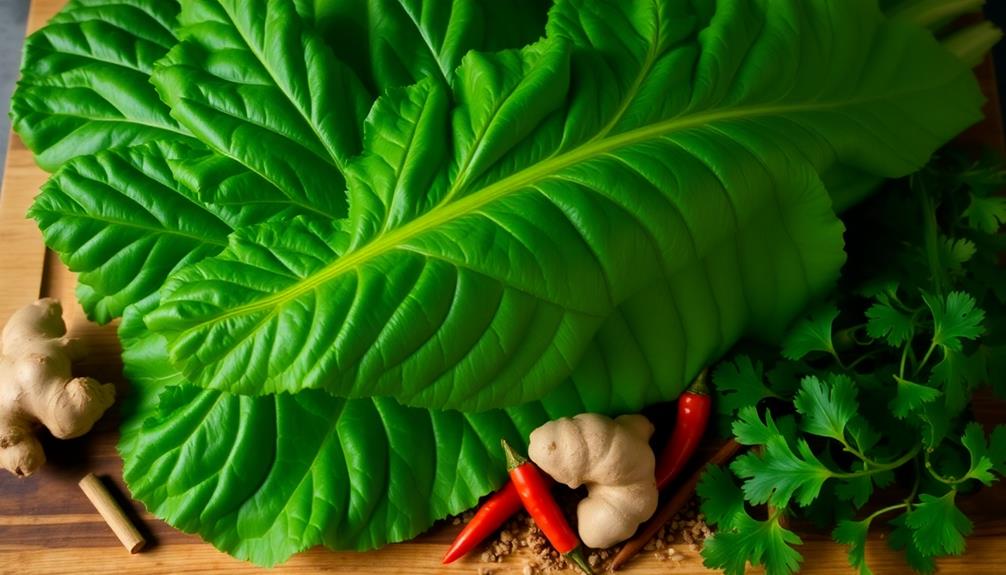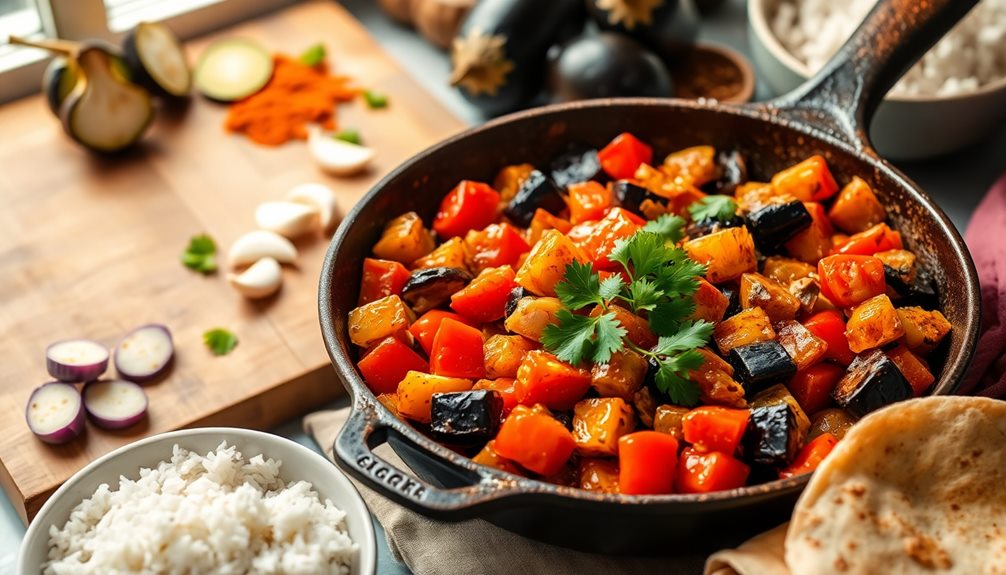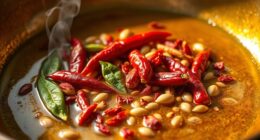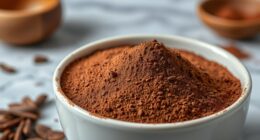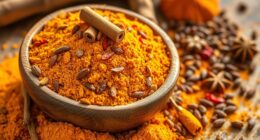Cassava leaf is a true culinary gem! This earthy and nutritious vegetable has long been a staple in many cultures, from South America to Africa and beyond. Rich in vitamins, minerals, and fiber, it's a powerhouse of goodness. Dive into the vibrant flavors by sautéing chopped leaves in oil, then simmering in creamy coconut milk. Season with zesty spices like cumin and cayenne for a flavor explosion. Whether you serve it over fluffy rice or alongside other traditional dishes, cassava leaf is a versatile ingredient that'll have your taste buds dancing. Get ready to discover its delicious potential and delight your family!
Key Takeaways
- Cassava leaf is a versatile, nutrient-dense ingredient with a rich history, thriving in diverse climates and deeply woven into global culinary traditions.
- The leaves are a valuable source of essential vitamins, minerals, and fiber, contributing to overall health and supporting digestive well-being.
- Cooking cassava leaves involves soaking, chopping, sautéing, and simmering in coconut milk, creating a creamy, aromatic, and customizable dish.
- Proper preparation is crucial to remove any toxic compounds, ensuring a safe and delicious culinary experience.
- Cassava leaf's earthy flavor profile allows for a wide range of spice blends and flavor combinations, encouraging creativity in the kitchen.
History
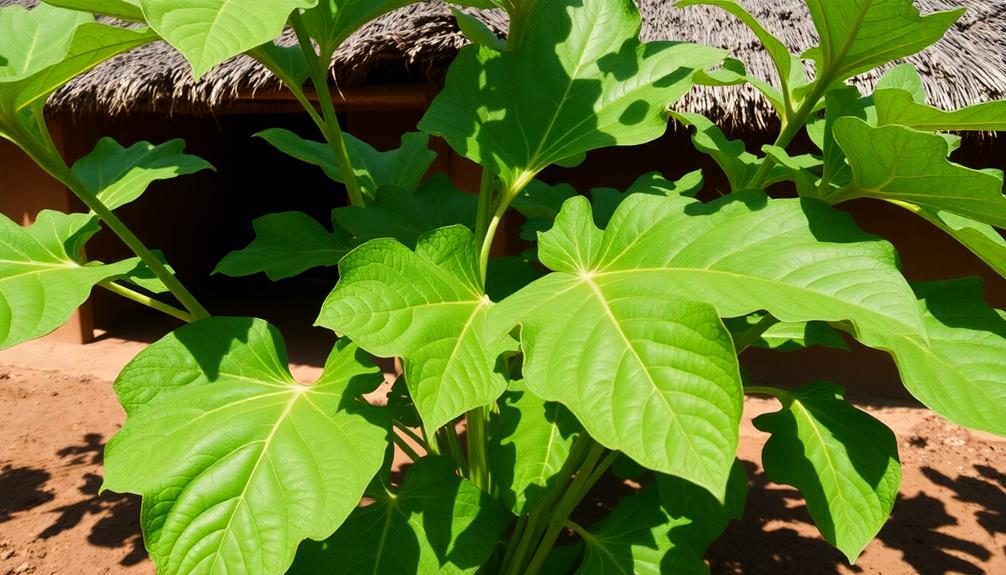
Originating from South America, cassava leaf has a rich history as a dietary staple across many parts of the world. For centuries, indigenous communities in regions like Africa, Asia, and the Caribbean have relied on this versatile vegetable as a crucial source of nutrition.
Cassava leaf's adaptability to diverse climates and its ability to thrive in poor soil conditions have made it a beloved ingredient, deeply woven into the culinary traditions of many cultures.
Today, cassava leaf continues to hold a special place in the hearts and kitchens of people around the globe. Whether simmered in soups, sautéed as a side dish, or incorporated into savory stews, this earthy, nutrient-dense leaf has endured as a time-honored ingredient.
Its resilience and versatility have allowed it to transcend geographic boundaries, becoming a cherished part of the world's diverse culinary tapestry.
Recipe

Cassava leaf is a staple vegetable in many parts of the world, especially in Africa and the Caribbean. It's a versatile ingredient that can be used in a variety of dishes, from stews to sautés. Cooking with cassava leaf can be a delightful experience, as it offers a unique flavor and texture.
Cassava leaves are rich in vitamins, minerals, and fiber, making them a nutritious addition to any meal. They're often used in traditional dishes, but can also be incorporated into modern recipes to add depth and complexity.
- 2 cups chopped cassava leaves
- 1 onion, diced
- 2 cloves garlic, minced
- 1 tomato, diced
- 2 tablespoons peanut oil
- 1 teaspoon ground crayfish (optional)
- 1 cup coconut milk
- Salt and pepper to taste
In a large pot, heat the peanut oil over medium heat. Add the onion and garlic and sauté until fragrant, about 2-3 minutes. Add the chopped cassava leaves and sauté for another 5 minutes, stirring occasionally.
Pour in the coconut milk and add the diced tomato. Season with salt, pepper, and ground crayfish (if using). Simmer the mixture for 15-20 minutes, or until the cassava leaves are tender and the flavors have melded together.
It's important to note that cassava leaves contain a compound called linamarin, which can be toxic if not properly prepared. Be sure to thoroughly wash and cook the leaves before consuming them.
Additionally, you can adjust the spice level to your personal preference by adding more or less ground crayfish. Enjoy your delicious cassava leaf dish!
Cooking Steps
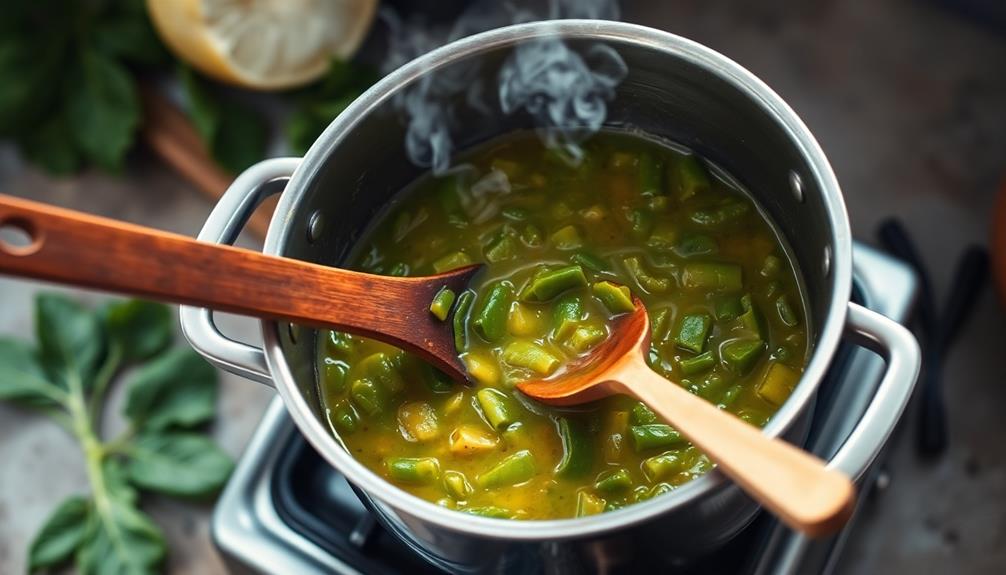
Start by soaking the cassava leaves in water to remove any dirt or impurities.
Once they're clean, drain the leaves and chop them into bite-sized pieces.
Next, sauté the chopped leaves in a bit of oil until they're tender.
For a delightfully creamy texture, stir in some coconut milk and season with your favorite spices to taste.
Step 1. Soak Cassava Leaves in Water

After purchasing the cassava leaves, it's time to soak them in water. This step helps remove any dirt, debris, or impurities that may be clinging to the leaves.
Simply fill a large bowl or sink with clean, cool water and gently submerge the cassava leaves. Let them soak for about 15-20 minutes, giving them a gentle swish every now and then. This will ensure the leaves are thoroughly cleaned and ready for the next step in the cooking process.
Once the soaking is complete, carefully lift the leaves out of the water, making sure to drain off any excess liquid. The leaves are now clean and prepped, so you can move on to chopping them up for your delicious cassava leaf dish.
Remember to handle the leaves with care, as they can be quite delicate. With a little bit of TLC, you'll have perfectly prepared cassava leaves, ready to be transformed into a flavorful and nutritious meal.
Step 2. Drain and Chop Leaves
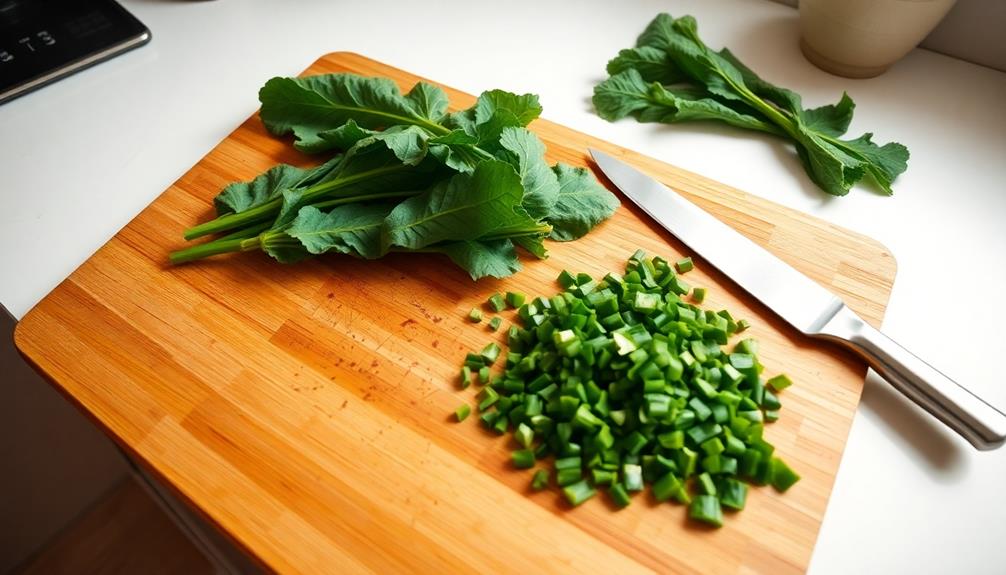
With the cassava leaves now thoroughly cleaned, it's time to move on to the next step. First, drain the leaves in a colander to remove any excess water. Don't worry if a few drops remain – they'll cook off nicely.
Next, grab a sharp knife and chop the leaves into bite-sized pieces. This will help them cook evenly and make them easier to eat. Try to keep the pieces around an inch or two in size.
As you're chopping, you might notice the leaves have a slightly tough, leathery texture. That's perfectly normal! Cassava leaves are hearty greens, and a little chopping is all they need to become tender and delicious.
Once you've chopped the entire batch, give the leaves a gentle fluff with your fingers to separate any clumps. Now you're ready to move on to the next stage of cooking. Get excited – the best is yet to come!
Step 3. Sauté Chopped Leaves in Oil
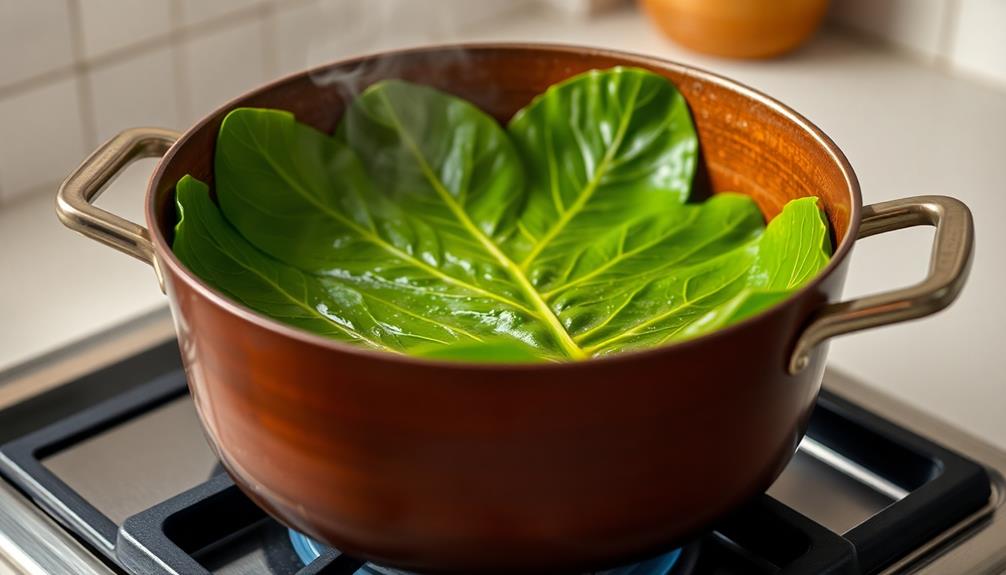
Next, heat a drizzle of oil in a large skillet over medium heat. Once the oil is shimmering, add the chopped cassava leaves.
Sauté the leaves, stirring frequently, until they're wilted and fragrant, about 5 minutes. Be sure to keep an eye on the leaves, as they can go from perfectly sautéed to burnt in the blink of an eye.
Adjust the heat as needed to prevent any scorching. You want the leaves to soften and develop a delicious, earthy aroma without drying out.
When the leaves are tender and cooked through, remove the skillet from the heat. Season the sautéed leaves with a pinch of salt and a sprinkle of pepper, to taste.
Give everything a final stir to combine the flavors. Your cassava leaves are now ready to be incorporated into your favorite dishes or enjoyed on their own as a flavorful side.
Step 4. Add Coconut Milk for Creaminess
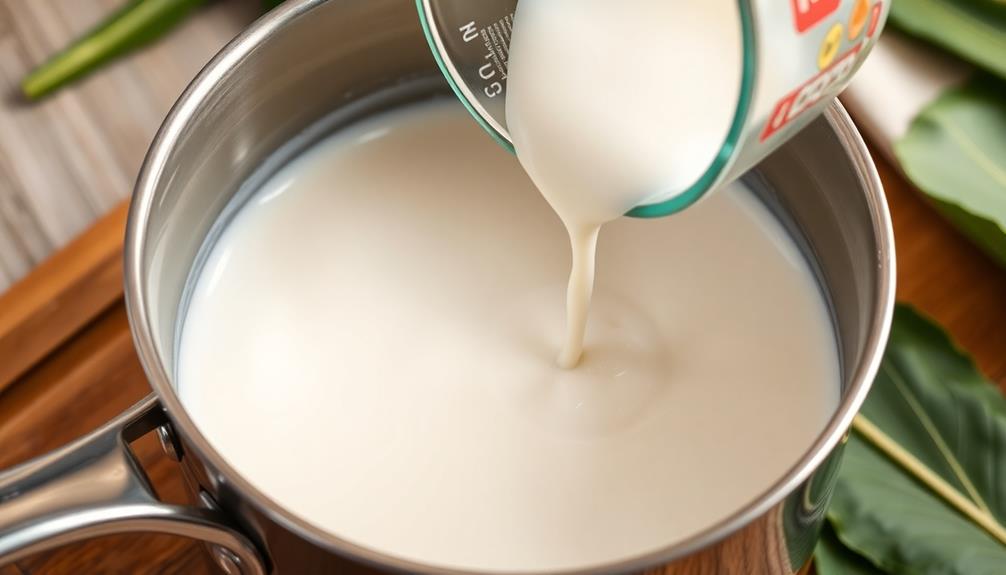
To take the sautéed cassava leaves to the next level, stir in some creamy coconut milk. The rich, velvety texture of the coconut milk will complement the earthy flavor of the leaves, creating a truly scrumptious dish.
Grab a can of full-fat coconut milk and pour it right into the skillet with the sautéed leaves. Gently heat and stir until the coconut milk is fully incorporated. The coconut milk will thicken the mixture, resulting in a luscious, creamy consistency.
For extra flavor, you can also add a pinch of salt, a squeeze of lime juice, or a sprinkle of your favorite spices. Cilantro or green onions make a fresh, vibrant garnish.
Serve this coconut-infused cassava leaf dish over steamed rice for a complete and satisfying meal.
The creamy coconut milk takes this humble vegetable to new heights of deliciousness. Your family is sure to love this flavorful and nourishing cassava leaf dish.
Step 5. Add Spices to Taste

Add any desired spices to the coconut milk-infused cassava leaves.
Experiment with aromatic spices like cumin, coriander, and turmeric to enhance the earthy flavors. A sprinkle of smoked paprika can lend a delightful smoky note, while a dash of cayenne pepper adds a lively kick.
Don't be afraid to get creative! You can even try a blend of spices, like a Cajun seasoning or a Caribbean curry powder, to take your cassava dish on a global flavor adventure.
Final Thoughts
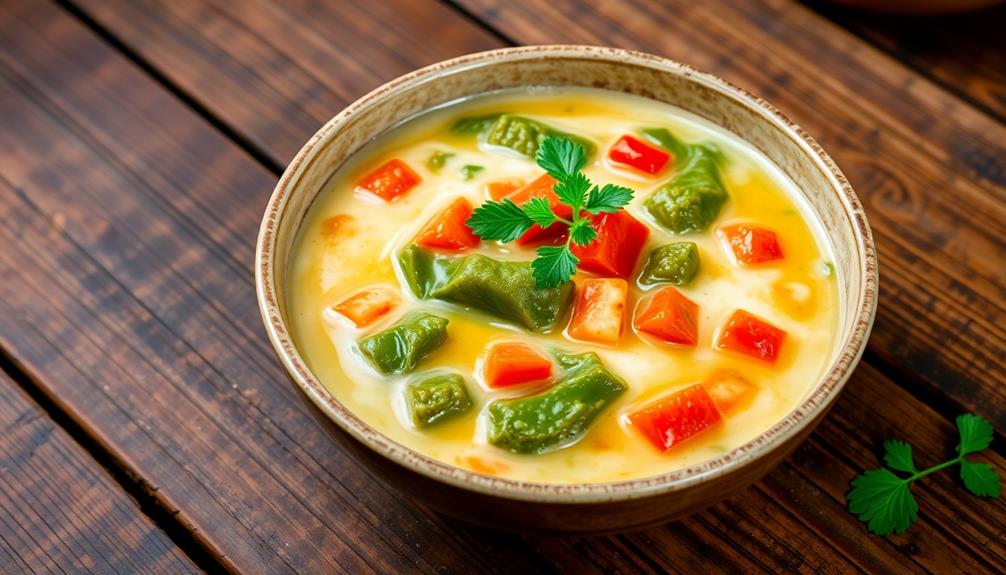
Cassava leaf's versatility is a true kitchen marvel, allowing you to craft mouthwatering dishes that captivate the senses. From hearty stews to vibrant salads, the humble cassava leaf can transform any meal into a culinary adventure.
Its earthy, slightly sweet flavor pairs beautifully with a symphony of spices, creating a unique taste experience that will have your family and friends raving.
As you explore the world of cassava leaf cooking, don't be afraid to experiment. Play with different flavor combinations, and let your creativity shine.
Whether you're looking to impress at a dinner party or simply enjoy a comforting homemade meal, cassava leaf is a fantastic ingredient that will never let you down.
Frequently Asked Questions
Is Cassava Leaf Gluten-Free?
Yes, cassava leaf is gluten-free. Cassava, the plant from which cassava leaf is derived, does not contain gluten, a protein found in certain grains like wheat, barley, and rye. So you can enjoy cassava leaf without worrying about gluten.
How Long Can I Store Cooked Cassava Leaf?
You can store cooked cassava leaf in the refrigerator for up to 3-5 days. Make sure to store it in an airtight container to maintain freshness. Avoid leaving it at room temperature for too long to prevent spoilage.
Can I Substitute Cassava Leaf for Other Greens?
You can substitute cassava leaf for other greens, but keep in mind the unique flavor and texture. It works well in dishes that call for hardy, earthy greens like kale or collards.
Are There Any Health Risks Associated With Cassava Leaf?
While cassava leaf is generally safe, it can contain cyanogenic compounds that may be harmful in large quantities. Consult your healthcare provider before consuming it, especially if you have any underlying medical conditions.
How Do I Select the Freshest Cassava Leaves?
When selecting cassava leaves, look for ones that are vibrant green, crisp, and free of any discoloration or wilting. Gently feel the leaves – they should be firm yet pliable. Avoid leaves that appear dried out or damaged.
